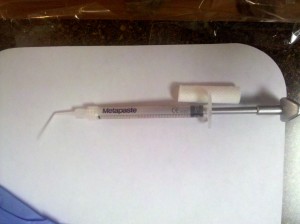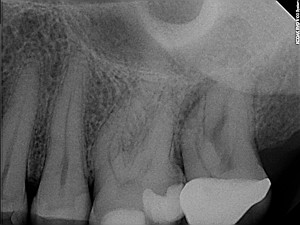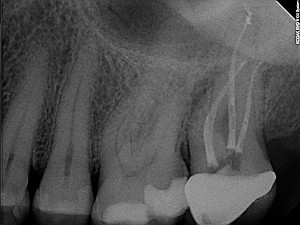I love Calcium hydroxide.
It is to endodontics what hot sauce is to food(or replace hot sauce with your favorite condiment). It has vast applications clinically, and is something I could not practice without. I am confused though, because when I talk about root canals with colleagues, many of them do not even have calcium hydroxide in their practices.
Calcium hydroxide is a compound that is available for use in dental offices. It has direct effects on bacteria, neutralizes bacterial toxins, appears to modulate inflammation, and increases the pH of the local environment. As a physical presence, Calcium hydroxide also reduces the effect of coronal leakage.
But it’s more than a list of individual actions. I suspect that calcium hydroxide does all of these things and more. The brand I prefer using is MetaPaste. It is a calcium hydroxide formulation that contains barium sulfate giving it radioopacity. It is syringeable, and can be applied directly to the canal.
I prefer to apply the calcium hydroxide under a small amount of pressure, then using a small lentulospiral to ensure that the medicament is applied uniformly throughout the length of the canal. Care must be taken to prevent the extrusion of CaOH, particularly near vital structures such as the mental foramen or the inferior alveolar canal. At subsequent visits, I will use Citric Acid or EDTA to remove the Calcium hydroxide, often with the assistance of an endoactivator.
As an endodontist, I receive referrals from other practitioners. Some of these cases have been started, some have not. The vast majority of teeth are, on some level, symptomatic. Ensuring that these teeth are not symptomatic upon return to the restorative dentist is imperative. My reliance on Calcium hydroxide in rendering these teeth asymptomatic cannot be overstated.
The following case was treated by me near the end of 2010. An 8mm pocket was detected on the buccal surface of tooth #15 by the referring doctor. The following diagnosis was made:
Pulpal:Necrotic Pulp
Periapical:Chronic apical abscess
At the initial visit, cleaning and shaping were completed and the canals were dressed with CaOH. One month later, the patient returned for reevaluation with a 3mm pocket on the facial. No bleeding was detected, and gentle attempts to move the probe apically were met with tissue blanching. The case was completed and the patient was referred back to his general dentist for additional restorative work.
While I strongly believe that one visit endodontic therapy has a place in the modern endodontic practice, I have yet to hear a good reason not to use Calcium Hydroxide when performing endodontic therapy over multiple visits. It’s good stuff!


